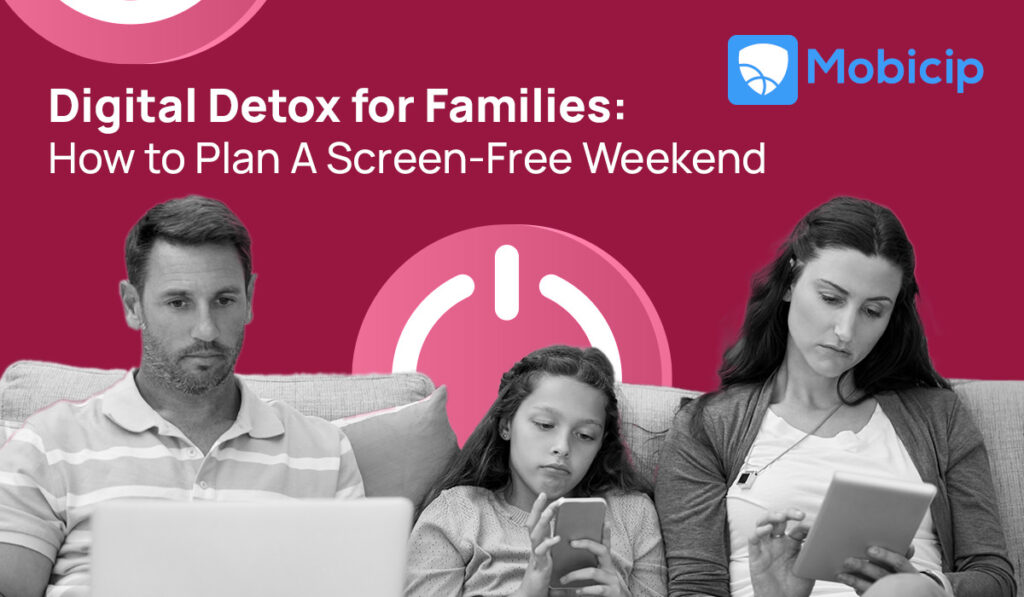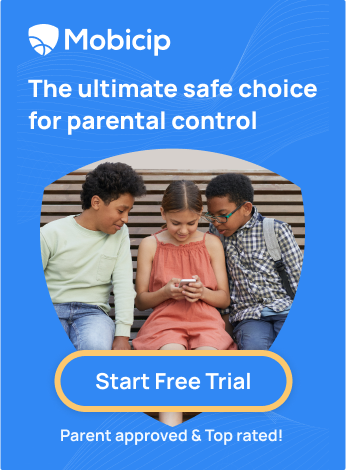Digital Detox for Families: How to Plan a Screen-Free Weekend

A digital detox is just like any other detox—you rid your system of a toxin to restore balance and well-being. In this case, the toxin is overindulgence in technology. While screens keep us connected, too much time online can act like a slow poison, draining our focus, disrupting sleep, and increasing stress and anxiety. Studies show that excessive screen time can rewire the brain, making it harder to concentrate, relax, or even enjoy offline moments.
This article will explore the benefits of a digital detox, practical ways to unplug, and how to build healthier screen habits for you and your family. But unplugging isn’t always easy, especially for kids and teens. That’s where Mobicip can help, offering smart parental controls, screen time limits, and content filtering to create a balanced digital environment. With the right approach—and the right tools—you can take control of your tech use and reclaim real-world connections.
Why Families Need Digital Detox
The concept of a digital detox—a deliberate break from electronic devices like smartphones—is gaining traction in the health and wellness space. Studies increasingly highlight the negative effects of excessive screen time on mental health, social connections, and overall well-being.
The Impact of Excessive Screen Time on Family Dynamics
Excessive screen time can create emotional distance within families. When parents and children are absorbed in their devices, real-life interactions take a back seat. Mealtimes, car rides, and even simple conversations become fragmented by notifications and scrolling. This lack of presence erodes emotional bonds, making it harder for families to connect, communicate, and build trust.
Social media also fosters comparison and FOMO (fear of missing out), especially among teens. Research has shown that frequent social media use correlates with increased depression. Seeing curated versions of others’ lives can leave kids feeling inadequate, lonely, or left out, further straining family relationships.
Mental and Physical Health Effects
Beyond emotional disconnect, screen overuse also affects mental and physical health. Studies show a direct link between screen time and sleep disruption, as blue light from devices interferes with melatonin production, leading to poor sleep quality. Over time, chronic sleep deprivation can increase stress, anxiety, and even depression.
Another growing concern is the link between technology use and ADHD-like symptoms. A study found that teens who frequently use digital media are twice as likely to develop ADHD symptoms, highlighting the cognitive effects of constant digital stimulation.
Physically, screen addiction leads to sedentary lifestyles, replacing healthier activities like exercise, outdoor play, and mindful relaxation. The World Health Organization (WHO) has even classified gaming disorder as a mental health condition, likening it to substance addiction.
Digital Detox: A Path to Reconnection
A digital detox offers a way for families to reset and reconnect in meaningful ways. By setting tech-free zones, limiting screen time, and encouraging offline activities, families can strengthen relationships, reduce stress, and improve overall well-being.
However, breaking free from digital dependence isn’t always easy. Mobicip helps families create a healthier tech balance with tools like screen time management, content filtering, and parental controls. By setting digital boundaries, families can enjoy real-life moments together, fostering a more present, engaged, and emotionally connected home environment.
Planning a Screen-Free Weekend: Step-by-Step Guide
A screen-free weekend can be a refreshing way for families to reconnect, reduce stress, and rediscover the joy of offline activities. However, success requires careful planning to ensure that everyone is on board and fully engaged. Here’s how you can make it happen:
Set Clear Goals for the Digital Detox
Before unplugging, decide why your family is doing a screen-free weekend. Do you want to improve communication, spend more quality time together, or simply take a break from digital distractions? Setting clear intentions makes it easier to stay motivated. Some families may focus on more face-to-face conversations, while others may aim for better sleep or outdoor time. Whatever the reason, having a shared goal helps keep everyone accountable.
Choose the Right Weekend for the Digital Detox
Pick a weekend that works for everyone’s schedule. Avoid times when work deadlines, school projects, or social events might make it difficult to unplug. Look for a weekend when the family can fully commit without interruptions. If possible, choose a time when the weather is nice to encourage outdoor activities.
Involve the Entire Family in the Planning Process
A screen-free weekend works best when everyone has a say. Talk to your kids and teens about the plan and listen to their concerns. Let them suggest activities they’d enjoy, so they feel included rather than forced into it. If children understand the benefits—such as more fun, relaxation, or uninterrupted family time—they are more likely to participate willingly.
Establish Ground Rules of Digital Detox
To make the detox effective, set clear rules in advance. Some ideas include:
- No phones or tablets at the dinner table
- Turning off Wi-Fi for the weekend
- Keeping TVs and gaming consoles off
- Designating a tech-free zone in the house
Make sure rules are realistic and flexible so that they don’t feel like punishments but rather opportunities for better engagement.
Prepare for Emergencies
Going screen-free doesn’t mean disconnecting from the world completely. Keep one phone accessible for urgent situations but place it in a drawer or out of reach. This ensures that you can handle emergencies while still maintaining the detox.
Engage in Fun Screen-Free Activities
Once screens are off, it’s time to fill the weekend with meaningful activities. Here are some great options:
Outdoor Adventures (No selfies please)
- Go for a hike, bike ride, or nature walk
- Plan a picnic at a nearby park
- Visit a beach, lake, or nature reserve for fresh air and relaxation
Creative Projects (No sharing on social media)
- Try family-friendly crafts like painting, DIY projects, or making handmade gifts
- Cook a meal together, letting kids help with preparation and decoration
- Start a home gardening project
Board Games and Puzzles (Dust them before you bring them down from the attic)
- Play classic board games like Monopoly, Scrabble, or Uno
- Work on a jigsaw puzzle as a team
- Try card games or create your own family game night
Storytelling and Reading (With dramatic narration perhaps? Unleash your inner drama queen or king)
- Read a book together, either aloud or individually
- Share personal stories from childhood or create a family storytelling challenge
- Write and act out a short family play or skit
By planning ahead and choosing activities everyone enjoys, a screen-free weekend can become a fun, rewarding tradition that strengthens family bonds and promotes healthier tech habits.
Challenges During Digital Detox and How to Overcome Them
| Challenge | How to Overcome It |
| Resistance from Family Members | Explain the benefits of a digital detox and involve everyone in planning. Start with small, gradual detox periods before committing to a full weekend. |
| Managing Boredom | Plan a variety of engaging activities like outdoor games, DIY projects, and family game nights. |
| Handling Withdrawal Symptoms | Expect restlessness or frustration in the first few hours. Encourage mindfulness activities like deep breathing, journaling, or short walks. |
| FOMO (Fear of Missing Out) | Remind everyone that social media will still be there later. Encourage real-world experiences that are more fulfilling, such as family bonding and outdoor adventures. |
| Breaking the Habit of Constant Checking | Store devices out of sight to reduce temptation. Set up tech-free zones in the house and encourage participation in hands-on activities. |
| Dealing with Urgent Work or School Needs | Plan ahead by informing colleagues or teachers about the detox. Set a designated time to check important messages if absolutely necessary. |
| Struggles with Unstructured Time | Create a flexible schedule with planned activities to provide structure while still allowing for spontaneous fun. |
| Feeling Disconnected from Friends | Encourage kids to invite friends for in-person activities like board games, picnics, or sports. Emphasize face-to-face interactions over digital ones. |
After completing a digital detox, take time as a family to reflect on the experience. Hold a family meeting where everyone can share what they enjoyed, what was challenging, and what they learned from the break. Discuss how disconnecting from screens impacted family interactions, moods, and overall well-being. With such practices, all challenges can be minimized or overcome completely for the next detox session, making each screen-free experience smoother and more enjoyable.
The Role of Mobicip in Supporting Digital Detox
A successful digital detox isn’t just about turning off screens—it’s about creating a sustainable balance between online and offline life. With so many digital distractions competing for our attention, it can be challenging to unplug, especially for children and teens who are deeply engaged in social media, gaming, and online content. This is where Mobicip comes in.
As a powerful parental control tool, Mobicip helps families manage screen time, reduce digital distractions, and build healthier tech habits. Instead of relying on willpower alone, parents can use Mobicip’s features to set clear boundaries and guide their children toward more mindful technology use.
With Mobicip’s features, parents can:
- Block apps and websites that contribute to excessive screen time, including social media, gaming, and streaming platforms.
- Set daily screen time limits to ensure kids and teens don’t overuse devices, encouraging them to engage in other activities like outdoor play and reading.
- Monitor online activity to track how much time is spent on different apps and platforms, helping parents identify potential areas of concern.
These tools make it easier to implement a digital detox, whether for a weekend or as an ongoing routine. Parents can customize restrictions based on their family’s needs, helping kids gradually reduce their dependency on screenswithout feeling completely disconnected.
Beyond screen time controls, Mobicip also provides valuable resources on digital wellness, offering tips and insights on fostering healthy screen habits. Whether you’re planning a temporary detox or seeking long-term balance, Mobicip can help.

Conclusion
A digital detox isn’t just about taking a break from screens—it’s about reclaiming control over our time, attention, and relationships. In a world where technology dictates our daily routines, choosing to unplug is a powerful act of self-care and connection. It’s a reminder that life exists beyond notifications and endless scrolling, filled with moments of laughter, deep conversations, and shared experiences. While the initial transition may feel uncomfortable, each detox strengthens the ability to be present, to engage fully with loved ones, and to cultivate healthier habits. Over time, the shift from mindless screen use to mindful interaction becomes second nature. By making digital detoxes a regular practice, families can redefine their relationship with technology, fostering a more balanced, fulfilling, and connected way of living—one unplugged moment at a time.





